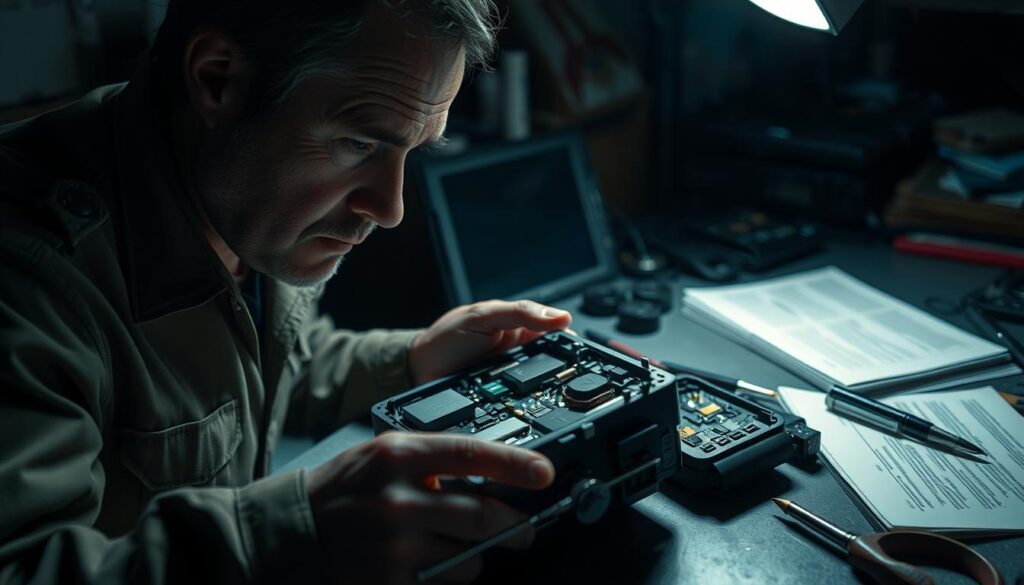In remote areas, satellite phones are key for staying in touch. MIRA Safety says knowing how to use them can save lives. It’s important to pick the right one for your needs.
I’ll show you how to use a satellite phone. We’ll cover the basics and why satellite communication is so valuable. This guide aims to simplify satellite phones and help you choose wisely.
Key Takeaways
- Understanding the importance of satellite phones in remote areas
- Learning how to use a satellite phone effectively
- Identifying the key benefits of satellite communication
- Discovering how to choose the right satellite phone model
- Preparing for emergency situations with reliable communication
What is a Satellite Phone?
A satellite phone connects to satellites in space, giving coverage all over the world. It’s different from regular cell phones, which use cell towers. A satellite communication device talks directly to satellites around Earth, working anywhere.
Overview of Satellite Phones
Satellite phones are made for places where cell phones don’t work. They’re great for remote or disaster areas. For more info, check out Wikipedia’s page on Satellite Phones.
These phones use satellites to send messages. The signal goes from the phone to a satellite, then to its destination. This can be another phone or a station that connects to regular phone lines.
How they Differ from Cell Phones
Satellite phones and cell phones use different ways to talk. Cell phones use towers, while satellite phones talk to satellites. This makes satellite phones better for places without good cell service.
Satellite phones are also tougher and last longer than cell phones. They’re good for rough places or when you can’t charge them for a while.
Common Uses in Various Industries
Satellite phones are used in many fields, including:
- Maritime: For talking on ships and boats at sea.
- Aviation: For planes, mainly in remote or oceanic areas.
- Emergency Services: For rescue and disaster help.
- Remote Expeditions: For teams in places with no cell service.
| Industry | Application | Benefits |
|---|---|---|
| Maritime | Ship-to-shore communication | Reliable communication at sea |
| Aviation | Aircraft communication | Safe and reliable communication over long distances |
| Emergency Services | Rescue operations | Effective coordination during disaster relief |
Benefits of Using a Satellite Phone
Satellite phones offer many benefits, like global coverage and being reliable in emergencies. They are key tools in many situations.
Global Coverage Capabilities
Satellite phones can reach anywhere, even where cell phones can’t. MIRA Safety says they work everywhere, including the poles. This makes them perfect for adventurers and workers in remote places.
For more on satellite phones, check out Tridon’s Pros and Cons page.
Reliability in Remote Areas
Satellite phones work where cell phones don’t. They’re great for people in remote or tough places. This includes construction sites, mines, or wilderness trips.
Emergency Communication Lifesaver
In emergencies, like natural disasters or accidents, satellite phones are lifesavers. They let you call for help and reach loved ones, even when other phones don’t work.
Choosing the Right Satellite Phone
Choosing the right satellite phone means looking at key features, popular brands, and cost. There are many options, so it’s important to know what you need.
Key Features to Consider
When picking a portable satellite phone, look at durability and build quality first. A tough design is important for harsh environments. Next, check the battery life and power-saving features.
Also, think about the phone’s coverage and compatibility. Some phones work with specific networks like Iridium or Inmarsat. Knowing this helps you choose the right phone for your area.
Popular Brands and Models
Several brands are well-known in the satellite phone market. Iridium and Inmarsat are leaders, with models like the Iridium 9555 and Inmarsat IsatPhone 2. The Iridium 9555 is small but covers the globe, great for adventurers and professionals.
The Inmarsat IsatPhone 2 has strong features and reliable coverage, best in areas with Inmarsat’s network. Comparing these models, like MIRA Safety does, helps you see their pros and cons.
- Iridium 9555: Known for compactness and global coverage
- Inmarsat IsatPhone 2: Offers robust features and reliable coverage
Cost and Budgeting Considerations
The price of a best satellite phone varies by brand, model, and features. Costs include the initial purchase and ongoing expenses like airtime and maintenance.
When budgeting, compare costs to benefits. A pricier phone with advanced features might be worth it if it meets your needs better. Plan your budget for both the initial cost and future expenses.
By thinking about these points, you can choose a phone that fits your budget and needs. This ensures you get the most from your satellite phone.
How to Set Up Your Satellite Phone
Setting up a satellite phone is a few steps. You need the right accessories and to follow the manufacturer’s guide. This will get you connected and ready to talk.
Essential Accessories You’ll Need
First, gather all the necessary accessories. You’ll need a compatible SIM card, an antenna (if not built-in), and a power source. This could be a battery or an external charger.
Also, think about getting a protective case. It helps keep your device safe, even in tough conditions.
| Accessory | Description | Importance Level |
|---|---|---|
| SIM Card | Required for network authentication | High |
| Antenna | Enhances signal reception | Medium |
| Power Source | Battery or external charger for powering the device | High |
| Protective Case | Protects the device from physical damage | Medium |
Step-by-Step Setup Instructions
With all your accessories ready, start setting up your satellite phone:
- Insert the SIM Card: Find the SIM card slot and put in the SIM card from your service provider.
- Activate Your Service Plan: Call your service provider to turn on your plan. You might need to register your device and plan.
- Power On and Configure: Turn on your phone and set up basic settings like language and location services.
- Establish a Connection: Make sure you’re outside with a clear view of the sky. Then, follow your device’s instructions to connect to the satellite network.

By following these steps and having the right accessories, you can set up your satellite phone easily. This way, you can communicate well, even in remote places.
Making and Receiving Calls
Making and receiving calls on a satellite phone is simple. You can stay in touch even in places without cell service.
Dialing Procedures Explained
To call with your satellite phone, make sure you have a clear view of the sky. Then, follow these steps:
- Turn on your satellite phone and wait for a signal.
- Dial the international prefix, country code, area code, and phone number.
- Press the call button to start the call.
To call the U.S. from anywhere, dial “00 1” followed by the 10-digit number.
Tips for Clearer Communication
Good communication is key, even in remote areas. Here are tips for clear calls:
- Speak clearly and at a moderate pace.
- Avoid background noise by finding a quiet spot or using a headset.
- Use simple language to avoid confusion.
Experts say, “Effective communication in remote areas requires the right equipment and knowing how to use it.”
“The clarity of communication over satellite phones can be significantly improved by minimizing background noise and speaking clearly.”
Managing Call Duration and Costs
Controlling call time is important to save money. Satellite calls can cost more than regular calls. Here are some tips:
| Strategy | Description | Benefit |
|---|---|---|
| Plan Your Calls | Schedule calls in advance to cut down on unnecessary time. | Lower costs |
| Use SMS When Possible | Choose text messaging for non-essential messages. | Costs less than voice calls |
| Monitor Your Airtime | Track your call time to avoid surprise charges. | Helps with budgeting |
Being mindful of call time and using your satellite phone wisely helps you stay connected while keeping costs down.
Text Messaging and Data Services
Satellite phones offer more than just voice calls. They also provide text messaging and data services. This makes them a great tool for staying connected in remote places.
Text messaging, or SMS, is a key feature of satellite phones. It lets users send and receive messages, even when voice calls aren’t possible. SMS features are great for when you need to keep things private or in emergencies.
Using SMS Features
To send an SMS on a satellite phone, you first go to the messaging menu. Then, you write your message and hit send. It’s easy, like using SMS on a regular phone. But, remember that satellite phone service providers might have special plans or fees for SMS.
When picking a satellite phone rental or service, think about the SMS options and costs. Some plans include a set number of SMS messages. Others might charge you as you go.

Understanding Data Pricing Plans
Data services on satellite phones let you email, browse the internet, and use apps that need data. But, data services can cost more than regular cell data. This is because satellite communication is more complex.
When you pick a data plan, it’s important to know how it’s priced. Some satellite phone service providers have plans based on how much data you use. Others might charge differently for different types of data activities.
Experts say, “Data pricing plans for satellite phones can really vary. So, it’s key to pick a plan that fits your needs.”
“The key to maximizing the utility of satellite phones lies in understanding and selecting the appropriate data and SMS plans.”
Charging and Battery Life
Maximizing the battery life of your satellite phone is key for constant communication in tough spots.
In remote areas, a dead satellite phone is a big problem. Keeping your battery in top shape is vital. This way, your device will work when you really need it.
Best Practices for Battery Maintenance
To keep your satellite phone’s battery healthy, follow these tips:
- Avoid deep discharging; charge your battery before it’s fully drained.
- Store batteries in a cool, dry spot when not using them.
- Use the right charger and avoid overcharging.
- Check battery health and replace it if it’s really worn out.
Energy-Saving Tips in Remote Locations
In remote spots, saving battery life is a must. Here are some energy-saving tips:
- Turn off your satellite phone when you’re not using it.
- Shorten backlight time and adjust volume to a good level.
- Use power-saving modes if your device has them.
- Send fewer texts and data to save power.
By sticking to these tips, you can make your battery life last longer. This ensures you stay connected, even in the toughest places.
Troubleshooting Common Issues
Troubleshooting is key for satellite phone users, more so in emergencies. Knowing how to spot and fix problems ensures your phone works right when you need it most.
Signal Problems and Solutions
Signal issues are common with satellite phones. They can happen if you’re in a spot with lots of trees, near tall buildings, or if something blocks your phone’s antenna. To fix this, make sure your phone can see the sky and isn’t blocked by anything.
Try moving a bit to get a better signal. If you’re in a forest, going up a bit or to an open area can help.

| Issue | Possible Cause | Solution |
|---|---|---|
| Weak Signal | Obstruction, Location | Move to a clearer location, Adjust phone position |
| Connection Drops | Satellite Alignment, Software Issues | Restart phone, Check for software updates |
Battery and Power Issues
Battery and power problems are common, mainly if you don’t take care of your phone. To keep your battery from draining too fast, follow the maker’s charging and care tips.
Some good habits include not overcharging, keeping the battery away from very hot or cold places, and using power-saving features when you can.
Software Troubleshooting
Software problems can mess with your satellite phone’s work. Keeping your phone’s software current is a big part of fixing issues. Always check for updates and follow the maker’s guide for updating.
If you run into software problems, restarting your phone might fix it. If it doesn’t, you might need to reach out to the maker’s support team.
Staying Safe While Using Satellite Phones
Using satellite phones means knowing about security threats. These devices are key in many fields, so keeping them safe is vital.
Satellite phones are strong but can face security issues. These include eavesdropping and cyber threats. Knowing these risks helps us protect against them.
Security Risks to Consider
One big worry is unauthorized access to your phone. This could let others listen in or steal your data. Also, phones can be jammed, making them useless.
Here’s a table showing common threats and their effects:
| Security Threat | Description | Potential Impact |
|---|---|---|
| Eavesdropping | Unauthorized listening to conversations | Confidentiality breach |
| Jamming | Interference that disrupts the phone’s signal | Loss of communication |
| Data Theft | Theft of sensitive information stored on the device | Compromise of sensitive data |
How to Protect Your Device and Data
To keep your phone and data safe, start with strong passwords and encryption. Also, keep your device’s software up to date. Updates often fix security issues.
Be careful with public Wi-Fi and avoid suspicious links. Use a secure SIM card and keep your device safe from thieves.
By understanding and addressing satellite phone security risks, we can have safer communication.
Satellite Phone Regulations in the U.S.
In the U.S., satellite phones follow specific laws and rules. It’s key for users to know these to stay legal and avoid trouble.
Understanding Legal Restrictions
Satellite phones face legal limits because they work outside regular cell networks. Regulatory bodies like the Federal Communications Commission (FCC) check these devices. They make sure they meet national and global standards.
Some satellite phone services are not allowed in the U.S. This is because of international rules or security reasons. Users must know these limits to use their phones right.
“The FCC plays a critical role in regulating satellite communications, including the use of satellite phones, to ensure they do not interfere with other communications systems.”
Permits or Licensing Requirements
To use a satellite phone in the U.S., you might need special permits or licenses. The rules depend on the service type and how you plan to use the phone. For example, business use might need different licenses than personal use.
- Check with the FCC for the latest rules.
- Know the terms and conditions of your service provider.
- Follow all laws and rules to avoid fines.
By knowing and following these rules, satellite phone users in the U.S. can use their devices legally and well.
Future Trends in Satellite Communication
The future of satellite communication is looking bright, thanks to new tech. We’ll see better satellite constellations soon. This means more global coverage and less delay. Companies like SpaceX and Amazon’s Kuiper Systems are leading the way.
They promise faster and more reliable satellite phone services. This is exciting news for anyone who uses these phones.
Innovations in Technology
New tech will keep changing satellite communication. For example, better antennas and signal processing will make satellite phones work better. It’s important to keep up with these changes when looking at satellite phone reviews.
Knowing about these advancements helps you choose the best satellite phone. It ensures you get the most out of your investment.
FAQ
What is a satellite phone and how does it work?
A satellite phone lets you call and receive calls using satellites in space. It connects to a satellite, then to a gateway station, and lastly to the public phone network.
What are the benefits of using a satellite phone in remote areas?
Satellite phones offer global coverage and are reliable. They are key for those in remote places, like the sea, air, and emergency services.
How do I choose the right satellite phone for my needs?
Look at coverage, durability, battery life, and cost when picking a satellite phone. Check out brands like Inmarsat and Garmin. Think about your budget and needs.
How do I set up my satellite phone?
First, get your phone, battery, and antenna. Then, follow the setup guide from the maker.
Can I use my satellite phone to send text messages and access data services?
Yes, many phones let you send texts and use data like email and the internet. But, data costs vary by provider and your needs.
How can I troubleshoot common issues with my satellite phone?
Check for signal, battery, and software problems. Use your manual or contact support for help.
Are there any security risks associated with using a satellite phone?
Yes, phones can face risks like eavesdropping and data breaches. Use encryption and secure protocols to protect your device and data.
Are there any regulations or legal restrictions on using satellite phones in the U.S.?
Yes, there are rules and laws in the U.S. for satellite phones. Know these to follow the law.
What are the future trends in satellite communication?
Expect better coverage, faster data, and more security in the future. These changes will make satellite phones more useful.
Can I rent a satellite phone for occasional use?
Yes, renting is an option for short-term needs. It can be cheaper than buying for occasional use.
How do I manage call duration and costs on my satellite phone?
Watch your usage and use prepaid plans. Use features like call timers to track costs.



